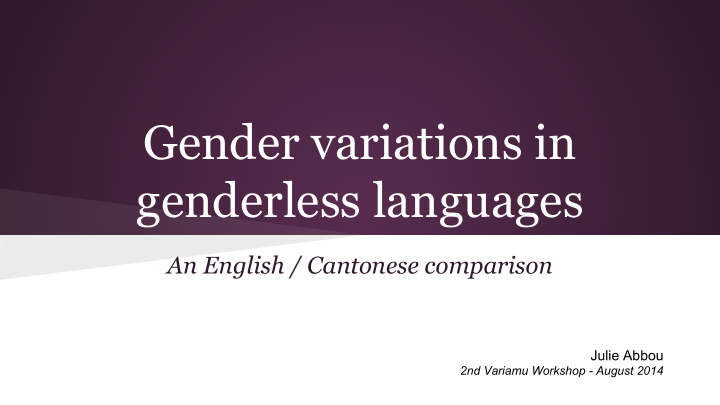



Gender variations in genderless languages An English / Cantonese comparison Julie Abbou 2nd Variamu Workshop - August 2014
● Gender as the relationships between masculinity and feminity ● Gender: a social and semiotic construction
“Gender: A Useful Category of Historical Analysis”, Joan Scott 1986 ● Cultural available symbols ● Normative concepts ● Political frame ● Subjective identity A primary way of signifying power relationships
Gender: a semantic category, structuralized through linguistic, semiotic and social dimensions. Focus on the linguistic forms indexing the meaning of gender.
Hypothesis 1. Gender varies in societies through times and spaces. Societies does gender. 2. Doing gender (West and Zimmerman 1987) is to build significations of masculine and feminine.
Hypothesis A different linguistic indexing of gender signification in different languages → Gender is a form A form: a transposable element (Rastier 2001) → Which linguistic realizations of the gender form?
The linguistic indexing of gender requires to look at different linguistic levels. → There is no language without gender Gradation of gender structuralization (grammaticalization) (Huddleston & Pullum 2005) → A more or less structuralized semantic categorisation
Transposability: The need for a contrastive approach
Gender in English Corbett (1991) ● Semantic level Motschenbacher (2010) ● Lexical level ● Lexical ● Morphosyntactical level ● Social ● Grammatical ● Referential Silverstein (1985) ● Reference ● Notion ● Forms
Gender in Cantonese
Gender in Cantonese Matthews & Yip (1994) ● Lexical terms ● Composed terms: leoi-jisang
Gender in Cantonese Matthews & Yip (1994) ● Morphological declensions -lou3 (for masculine referent) ○ -poh4 (for feminine referent) ○ - jai2 (smallness, masculine/generic) ○ -léui5 (smallness, feminine) ○ ● 2nd person singular pronoun: nei5
Corpus 30 speakers 20 sentences
Corpus ● Human-refered terms (nouns, pronouns) ● Different syntactical contexts (subject, object, genitive, singular/plural, …) ● Non-human animate refered terms ● Generic terms ● Deictic ● Decoy sentences
Transposing the gender information: ● Disambiguating (to add gender) ● Shunning (to erase gender)
Pronouns ● 75%: 3d person singular pronoun kéuih ● 25%: Alternative strategies ○ Adding a feminine stem Using Chinese (Mandarin) characters ○ Choosing a lexical form ○
Tony and Jenny are going to Macau. He wants to try the egg tart there, while she wants to do some sightseeing. ● Nominal resumption (to maintain gender information without grammaticalization) → 12 speakers ● Shunning of gender information → 7 speakers ● Alternance of noun and pronoun → 9 speakers
He is a very nice guy ● Ungendered sentence → 20 speakers ● Masculine form (pronoun) → 7 speakers Michard (1999): Masculine primary signification: generic ★ Masculine secondary signification: male ★ Feminine primary signification: female ★ (Feminine secondary signification: human) ★
This actress speaks loudly ● Shunning gender → 9 speakers ● Maintaing of gender information by combination of 3 characters → 21 speakers cf . Michard’s analysis
Her boyfriend is an American ● Neutral translation of American → 97% ● Adding of a masculine stem → 1 speaker
Conclusions ● Major tendency in Cantonese: unmarking gender ● The gender loss is morphosyntactical ● It is easier to shun the masculine than the feminine
Conclusions No morphological edge for pronoun gendering → A linguistic potentiality of Cantonese Further directions: ● The generic/masculine relationship and the emergence of a feminine pronoun ● Analytical tools: are compositional strategies morphosyntactical or morphological?
Thank you for your attention
Recommend
More recommend